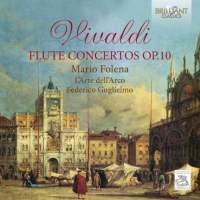Texte paru dans: / Appeared in: |
|
|
Outil de traduction ~ (Très approximatif) |
|
|
Reviewer: Alan
Swanson Though the traverse flute was already popular in France and Germany at the beginning of the 18th century, its use in Italy took some time to settle in, and Stefan Rampe observes that Vivaldi continued to use the recorder until 1740. These six concertos, specifically advertised as for traverse flute, were published in Amsterdam in 1729. (In fact, 16 of Vivaldi’s 25 published collections of music appeared there between 1711 and 1740.) Vivaldi’s earliest use of the traverse flute, however, does not come before 1727, in his opera Orlando furioso (RV 728), perhaps not coincidentally the year after the great German flute virtuoso Joseph Joachim Quantz came to Venice for a series of performances, as Guglielmo points out in his sensible notes (printed, alas, in punishingly small type). Indeed, the late 1720s was a busy time for Vivaldi, with many of his Amsterdam publications coming onto the market. As at least three of these concertos, Nos. 1, 3, and 6, are reworkings of earlier concertos for recorder, and No. 2 is proposed to have come from around 1710 or so, we might easily see the transformation of earlier recorder concertos into works for traverse flute as a market-driven strategy. Played as well as they are here, this is our gain. The “Storm at Sea” is suitably tempestuous, for which Eric Bosgraf’s performance of the earlier recorder version of this concerto (Brilliant, Fanfare 33:5) is an interesting contrast. The same is true, as well for the performances of No. 2, “Night,” where Folena is just a bit more relaxed. No. 3, “The Little Garden,” is full of those bird sounds that feature in so many pieces of pastoral music of all ages, from Antonio Scandello’s “Little White Hen,” beloved of so many youthful madrigal groups, to Ottorino Respighi’s Gli ucelli. I am generally pleased with the accompaniments of L’Arte dell’Arco, but those who like their Baroque concertos to be polished off as quickly as possible may find Guglielmo’s speeds on the relaxed side. As far as I can tell at this writing, this is the only recording available of the six concertos of op. 10 on period instruments and would be self-recommending even if it were not quite as good as it is. As it is, however, it is very good indeed and can be recommended. | |
|
|
|
|
Cliquez l'un ou l'autre
bouton pour découvrir bien d'autres critiques de CD |
|




